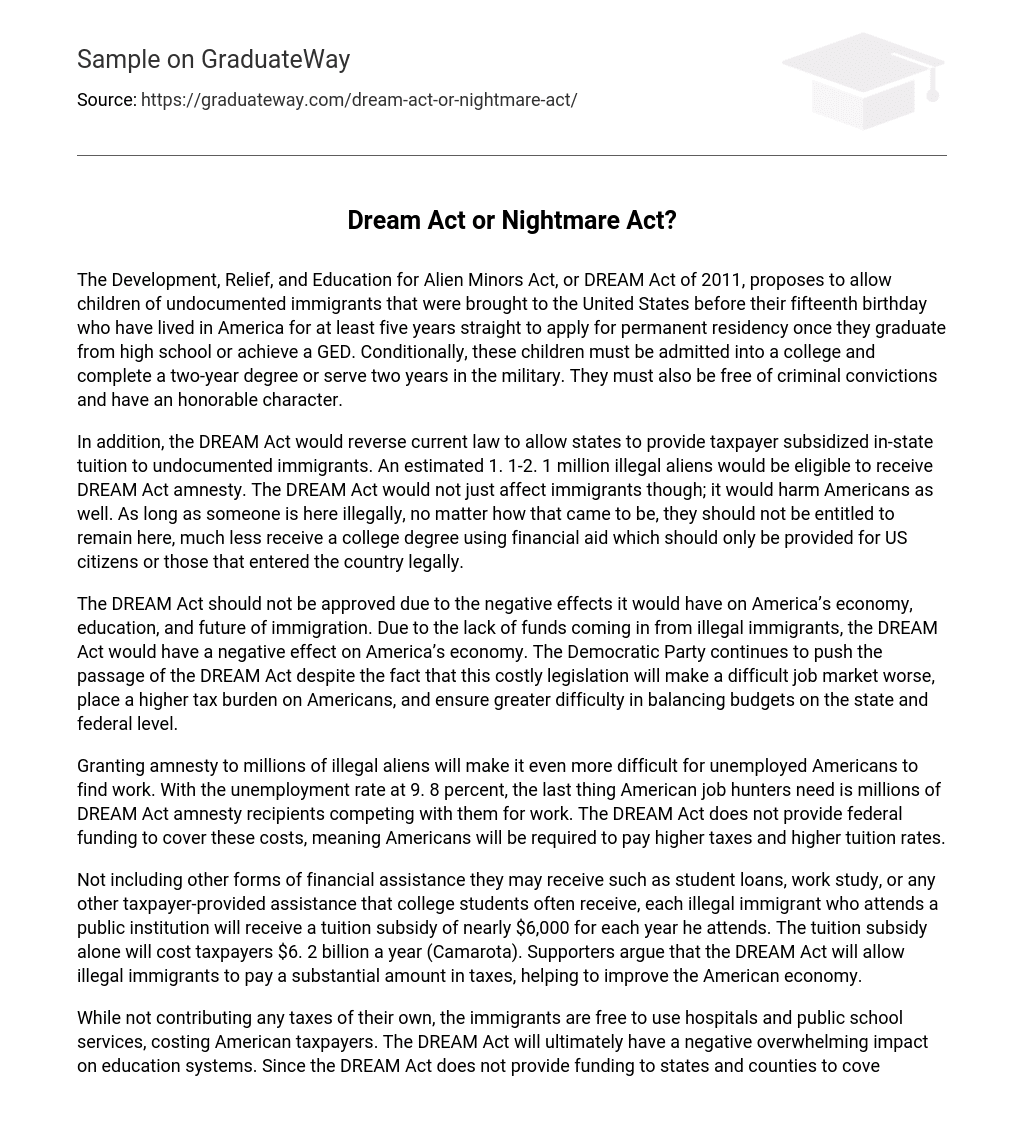The DREAM Act of 2011 suggests that children of undocumented immigrants, who arrived in the United States prior to turning fifteen and have resided in America for a minimum of five consecutive years, should be permitted to seek permanent residency after high school graduation or obtaining a GED. Nonetheless, these children must fulfill specific requirements including acceptance into college and completion of a two-year degree program or serving two years in the military. Furthermore, they must possess an untarnished criminal record and exhibit positive character traits.
The DREAM Act would modify existing laws to allow states to provide subsidized in-state tuition to undocumented immigrants. Approximately 1.1-2.1 million unauthorized foreigners would be eligible for DREAM Act amnesty. The DREAM Act affects not only immigrants but also Americans. It argues that individuals who are present unlawfully should not have the privilege of remaining in the country or receiving financial aid for a college degree, as those benefits should be reserved exclusively for US citizens or legal entrants.
The approval of the DREAM Act should be halted as it will have harmful consequences for America’s economy, education system, and immigration future. The DREAM Act would negatively impact America’s economy by lacking funds from illegal immigrants. Despite the expensive nature of this legislation, the Democratic Party continues to advocate for its enactment, worsening an already difficult job market, increasing taxes on Americans, and making budget balancing more challenging at both state and federal levels.
Granting amnesty to millions of illegal aliens will make it even more difficult for unemployed Americans to find jobs. With the unemployment rate at 9.8 percent, the presence of millions of DREAM Act amnesty recipients looking for employment will only intensify competition among American job seekers. Moreover, the DREAM Act does not provide federal funding for these costs, leading to higher taxes and tuition rates for American citizens.
The DREAM Act proponents argue that granting tuition subsidies to illegal immigrants attending public colleges, excluding other financial aid options like student loans or work study, will amount to approximately $6,000 per year. As a result, taxpayers are projected to bear an annual cost of $6.2 billion for this tuition subsidy (Camarota). They believe that this act will allow illegal immigrants to contribute significantly through taxes and ultimately benefit the American economy.
The immigrants, although they do not contribute taxes, are able to utilize hospitals and public schools, which results in costs for American taxpayers. The implementation of the DREAM Act will have an overall detrimental effect on education systems. As the act does not allocate funds to states and counties to cover these additional expenses, its enactment will necessitate tuition hikes, tax increases for enrollment expansion, or a decrease in available spaces for American citizens in these schools (Camarota).
Camarota predicts that around 500,000 foreign students will enroll in public institutions soon after the DREAM Act is implemented. Another 500,000 students are estimated to enroll over the next 15 years. This would mean that undocumented immigrants would be given advantages while deserving American students are denied educational opportunities. Furthermore, it would also create difficulties for American students in obtaining financial aid and scholarships.
In an article titled “Estimating the Impact of the DREAM Act,” Steven Camarota discusses the challenges that students will face due to the increase in tuition fees. This is a concern because many Americans already struggle to afford college education. Research shows that high costs are a major reason why about one-third of college students drop out before completing their degree. Lawmakers need to consider that implementing the DREAM Act will further strain resources and limit educational opportunities for American citizens. This is because approximately one million students will be enrolled in state universities and community colleges (Camarota).
Proponents of the DREAM Act contend that it will notably enhance tax revenue as amnesty recipients, who possess a college education, will earn higher incomes, resulting in increased tax contributions. Nevertheless, Camarota suggests that any tax advantages will only be realized in the long run and will not address the immediate challenges faced by public institutions in accommodating the substantial influx of new students generated by the Act. This limited capacity in institutions will consequently displace US citizens, leading to diminished lifetime earnings and tax payments.
In addition, the requirement of only two years of college under the DREAM Act means that undocumented immigrants will not be able to obtain a degree and therefore will not make significant contributions to tax payments. This issue is worsened by the high dropout rate among college students, including illegal immigrants. As a result, taxpayers are funding their enrollment and financial aid without gaining long-term benefits (Camarota). Consequently, the DREAM Act will have negative consequences for the United States. It will weaken respect for immigration laws, increase rates of illegal immigration, and necessitate additional immigration-related legislation. The potential opportunities provided by the DREAM Act may attract struggling parents to engage in illegal immigration, further undermining respect for our nation’s immigration laws. This could also encourage parents from other countries to continue defying immigration laws by smuggling their children into the United States with hopes of obtaining citizenship and a future in America.
Passing the DREAM Act would require passing more laws in the future because of the increase in new undocumented immigrants. Even if supporters of the DREAM Act call for deporting future immigrants, it raises concerns about why those who become citizens through the Act are treated differently from other undocumented immigrants. The DREAM Act does not effectively tackle the problem of undocumented immigrants in America and introduces inconsistencies for future possibilities, contradicting its initial objective.
The implementation of the DREAM Act could enhance the living conditions of undocumented immigrants. However, this achievement will negatively impact American citizens in terms of their economy, education, and the future of immigration. By rewarding undocumented parents who engaged in illegal activities, the act fulfills their initial goal, which was to provide a better life for their children.





